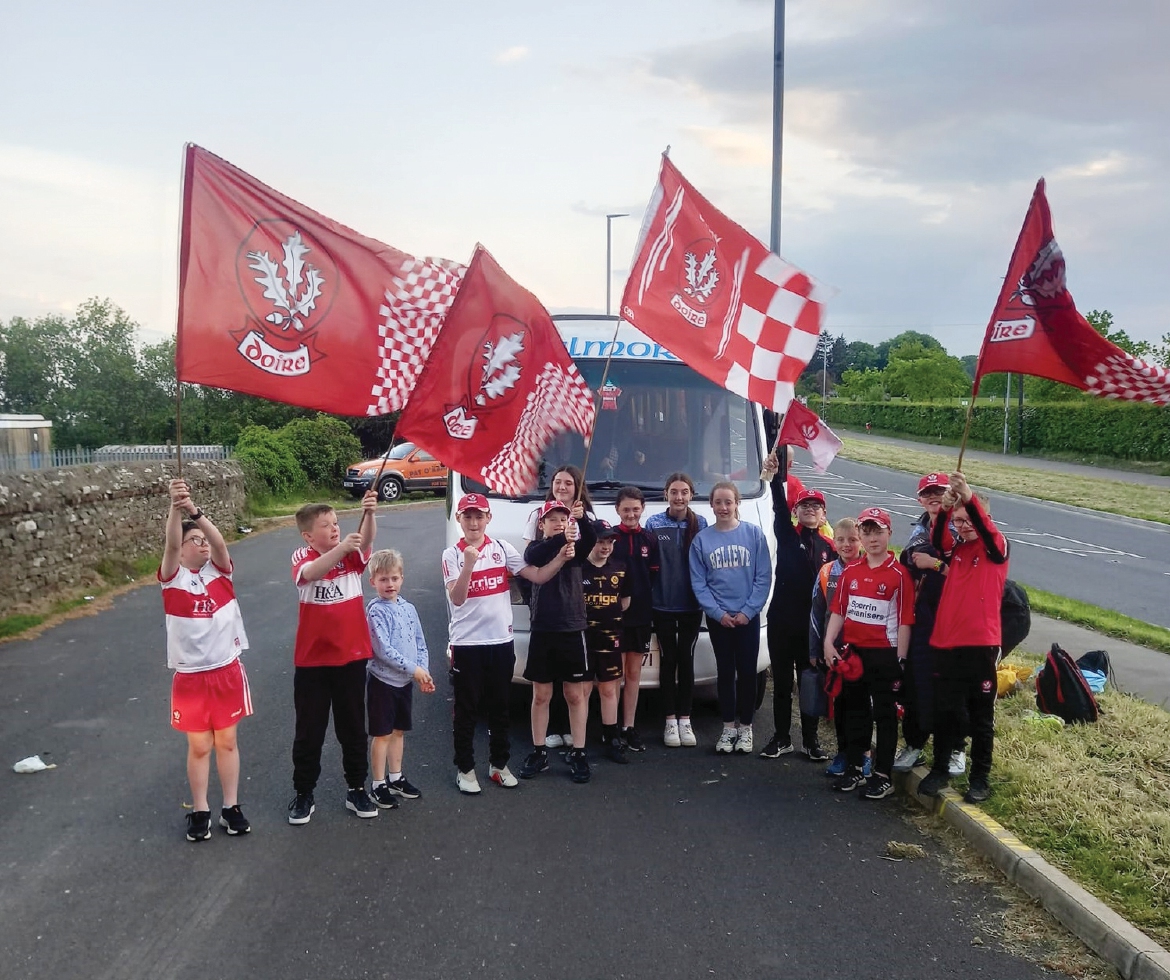With the club championship season well under way, Michael McMullan spoke to some of Ulster’s youngest clubs about their challenges and successes.
East Belfast (Down)
FOUNDERS David McGreevy and Richard Maguire were married into East Belfast and a desire for their kids to play Gaelic games planted a seed.
One Sunday morning in 2020, David composed a text to Richard of an initial proposal and the wheels were in motion. An email address was set up and a tweet posted to gauge interest.
“Then it exploded,” explains their current club secretary. Their inbox was in overdrive, ranging from GAA exiles living in Belfast looking for a club to total newcomers with the intrigue of something new.
What was their biggest challenge?
“Everything,” David jokes. “There was nothing there, we had no structures and every day there would’ve been 50 or 100 emails from people looking to join.”
One of the biggest challenges was getting a double signature bank account up and running.
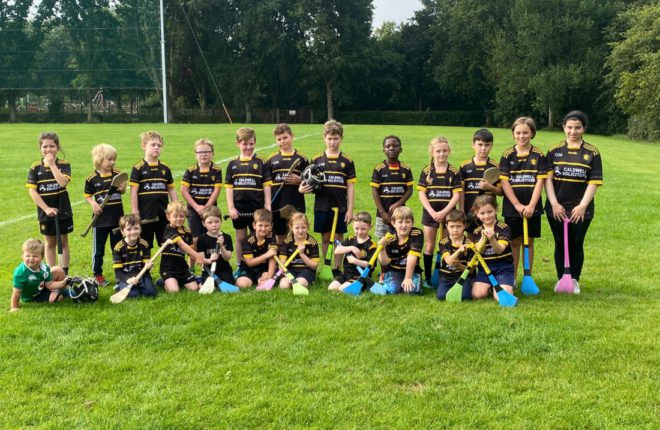
EARLY SHOOTS…East Belfast’s first ever hurling blitz
The club needed equipment and for all their players to be fully insured.
“We were under big scrutiny so we had to make sure all our governance was bang on, so we couldn’t accept any money until we had the bank account,” David said.
Soon, they formed a committee and sought out those with different skill sets to make the club tick.
“It was stressful at the start,” David admits. They even questioned the sanity of pulling a club from thin air.
But, two years on, it’s a huge success. The satisfaction stems from seeing their members growing into a community and new circles of friends created.
“We then started up the kids last year and they all have their friends they meet every Saturday. They are friends for live and will grow up together,” David points out.
Their initial motivation for the club has been fulfilled.
David recalls a moment when coaching officer Brian McGuigan invited him along to a coaching session of local Special Olympics club the Titanic Tigers.
Helping a young camog on with her camogie helmet, her response summed up the sense of belonging and the success of trying something new.
“She was unable to communicate with me, but she signed “thank you” back to me in Makaton,” he said.
“That’s the nicest moment so far, having kids that want to be involved and haven’t had a chance of being involved.”
Leagues and championships will fall into place when the time is right, but East Belfast is about much more.
“It has to be about involving everyone. The community haven’t had a GAA club before and it is great they are seeing what GAA is all about They are just absolutely delighted to be part of something,” David added. “Every week we are getting half a dozen or a dozen new members per week. When we were in the news recently, we were getting a dozen a day.
“People are interested in joining. The people who run the social media are good communicators and we come across as very welcoming and I think we are.”
Culmore Cú Chulainns (Derry)
DERMOT McErlean would go to Croke Park and the conversation with any random stranger always began with one thing – the name of their club.
“We didn’t identify with any club and didn’t belong to a club,” Dermot recalls.
Born and raised in Culmore, on the outskirts of Derry City, his father hailed from Lavey. The GAA roots were strong.
A population of around 800 spiralled to around 7,000 by 2015. Even with the crash of the building boom, houses were still being built and sold in Culmore.
“We had the highest average of children under 12 years of age, the national average is 22 per cent and we were up as 27 or 28,” McErlean said.
“Children were involved in other clubs and when we did our homework, they were involved in three other clubs throughout the town,” said of their initial plans to start the club in 2016.
By January of the following year they presented a proposal to Derry GAA before putting meat on the bones.
“Myself and two brothers and five other Gaels went away and had meetings,” McErlean recalls.“We were only going to do this once, so we were going to do it right and do it the hard way.”
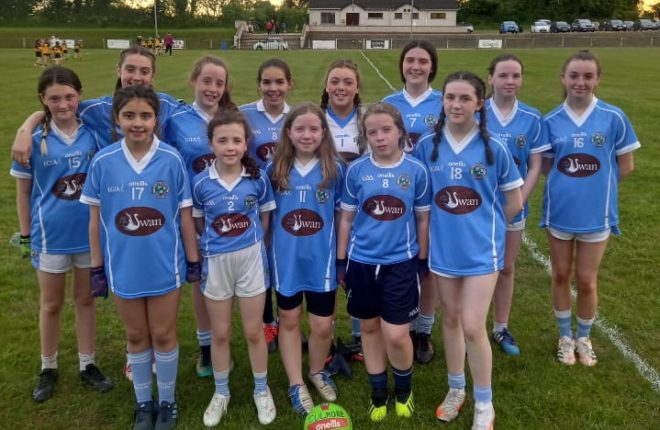
DERRY GIRLS…Culmore have added ladies football to their club
They knocked on the doors of Culmore and with 1,500 signatures of support they had a case.
Political parties and community groups added their support and the wheels began to turn. After putting their case to Ulster GAA, the green light arrived in June 2017.
The club have based themselves at Thornhill College. They have also purchased their own bus to ferry them to blitzes here there and everywhere. It was booked out for every Sunday of Derry’s Ulster winning summer.
“They are GAA people and are now immersed in GAA culture…to me that is very rewarding. The biggest challenge we had was convincing non-traditional GAA families to give it a go,” McErlean said. “Derry would’ve been known as a soccer city. I am all about maximising participation and the only way (to grow GAA) is to get them in young.”
The satisfaction comes from 94 smiling faces at their recent summer camp and parents knowing it is a safe place for their children to thrive. The kids who had never lifted a ball before 2017 are “accomplished players” in their current u-11.5 team, with ladies teams also on board.
At a recent meeting with other club chairpersons, a conversation about success begins.
“Affiliation, becoming a GAA club,” is McErlean’s mark of success for Culmore. “I knew we would give our best shot at this, that we could get more children in this city playing Gaelic games. To me, that is more than any trophy cabinet with silverware in it.
“If you are a proper Gael, you are in it for the right reasons. The more children we can get lifting a ball or a hurl, that’s what I am about.”
Cúchulainn an Ghleanna (Tyrone)
WHEN former Tyrone hurling Development Officer Peter Kerr was tasked with the growth of more hurling clubs in the county, the Clogher Valley was earmarked and Cúchulainn an Ghleanna
was born in 2016.
“He brought a few like-minded people together and got the ball rolling,” said current Chairman Cathal McGarry.
“I got involved a year later after Declan Bogue (a committee member) got chatting at a wedding and convinced me to come on board.”
Like any new sporting club, McGarry admits it wasn’t without its challenges, but the initial success is about overcoming them.
“At the start, I suppose the difficulty was getting the word out there,” he points out. “This is a hotbed of football around Ballygawley and Aghaloo.
“It was about making hurling accessible to youngsters and normalising it. The game was as alien to Gaels around here as lacrosse was. Hurling is about getting hurls in the hand and the game will sell itself…that’s what we found.”
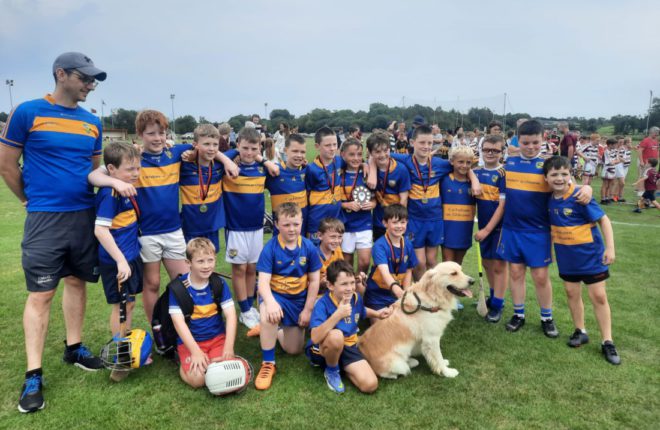
NEXT GENERATION…Cúchulainn an Ghleanna
From “30 or 35” in the beginning, their underage numbers were near 50 by the end of the second year and all was good until Covid arrived, bringing doubt to their door. Would the club survive?
“We basically stopped for a year. That was a concerning time as we were worried if it was the end of the club,” McGarry admits.
They held meetings over Zoom. Hurling tips were promoted via social media and drop off points were arranged if any kid wanted a hurl of sliotar to hone their skills. It worked.
“We were the first team in Ireland back after the lockdown. And had 85 children on the first night,” McGarry said.
Now, they have 100 children on their books and 30 adult players signed up to compete in the Tyrone Junior Hurling Championship for the first time. The club had 15 young camogs gracing Croke Park at half time on camogie finals’ day. Their next venture is an adult camogie team as they continue to look into the future.
On the underage front, McGarry said scheduling was their biggest challenge in a world that offers so many sports and pastimes. He is full of praise for the local football clubs who stay away from their traditional Monday hurling coaching night.
“They have all been very helpful,” he said. “The football coaches are saying they notice the tenacity and the skill have improved from the hurling and how it is bringing them on as footballers.”
Anraí Seioghe and Maire Aine (Antrim)
A REALISATION that hurling was absent in the New Lodge, Carrickhill and Newington areas of Belfast was the beginning of Anraí Seioghe and Maire Aine, a camogie and hurling club born out of lockdown in 2021.
The club, led by chairperson Gavin Curran, felt they needed something fresh to attract players to the game.
“The idea of a hurling team was going around for a few years and then the camogs floated the idea of a team as well,” tells James Dunn, a member of the club’s PR team.
“In the beginning we set up taster sessions, with ones coming along to make friends in their community and pick up a sport.”
The club began in an online capacity as the world was locked away to curb the spread of Covid, but once the restrictions were lifted, Anraí Seioghe and Maire Aine stretched its legs.
“We went up Mallusk and began training,” Dunn said. “When things opened up again, plans moved forward. There were a lot of new players coming to try and sport and ended up loving it…it was the same with the camogs.”
Pulling everything together and dealing with the cost was an initial obstacle the club now have under control.
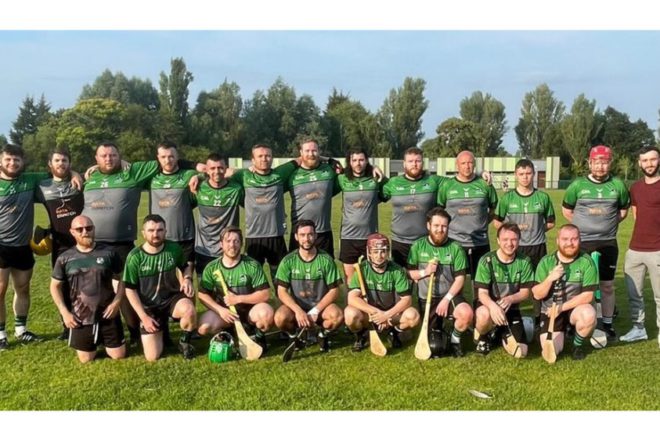
GROWING THE GAME…The Anraí Seoighe & Maire Aine club was formed to increase the participation of hurling in Belfast
“Setting up a new club is costly, but we have that sorted out and we are looking forward,” Dunn said.
The first competitive season, in 2022, was a “mixture of highs and lows”. The camogie team have found their feet, but the hurlers are still in search of a first win.
“There was a problem with leagues and championships clashes (in hurling), but that should all be ironed out next year,” Dunn said.
“The camogs have got up and running and are starting to get results. The beginners are getting on well and gelling as a team, as are the fellas but they haven’t managed to get a win yet, but we are getting there.”
With the new school year around the corner, the club have already made plans to expand their underage ranks. Initially, a small group of boys and girls were on board.
“We have our coaches all set up and we are planning to push the sport to get more youngsters to come along to try it out,” Dunn concluded.
Receive quality journalism wherever you are, on any device. Keep up to date from the comfort of your own home with a digital subscription.
Any time | Any place | Anywhere




